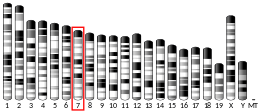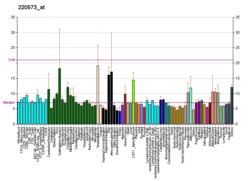KLK14
Kallikrein-14 is a protein that in humans is encoded by the KLK14 gene.[5][6][7]
Kallikreins are a subgroup of serine proteases having diverse physiological functions. Growing evidence suggests that many kallikreins are implicated in carcinogenesis and some have potential as novel cancer, skin disorders and other disease biomarkers.[8] This gene is one of the fifteen kallikrein subfamily members located in a cluster on chromosome 19. Apart from its common transcript, an additional transcript variant has been described but its difference in function and full length nature has not been determined.[7]
KLK14 displays optimal trypsin-like activity at an alkaline pH of 8.0 and remains active in the pH ranges of 5.0 - 9.0 and is produced as a zymogen, but can function also in a chymotrypsin-like fashion.[9] Activation of KLK14 is mediated by KLK5 and after KLK14 activation, it further amplifies the activity of KLK proteases by a positive feedback loop via cleavage of pro-KLK5, which is a central player in KLK cascade.[10][11] KLK14 function has not yet been fully elucidated, but its most notable substrate is PAR2.[12][13] Its activity is inhibited by a wide variety of proteins, like macroglobulins, serpins, and the serine protease inhibitor lympho-epithelial Kazal-type-related inhibitor (LEKTI) and also micro-environmental pH; and single-metal-ion inhibitors of KLKs among others.[14]
References
- GRCh38: Ensembl release 89: ENSG00000129437 - Ensembl, May 2017
- GRCm38: Ensembl release 89: ENSMUSG00000044737 - Ensembl, May 2017
- "Human PubMed Reference:". National Center for Biotechnology Information, U.S. National Library of Medicine.
- "Mouse PubMed Reference:". National Center for Biotechnology Information, U.S. National Library of Medicine.
- Lundwall A, Band V, Blaber M, Clements JA, Courty Y, Diamandis EP, et al. (June 2006). "A comprehensive nomenclature for serine proteases with homology to tissue kallikreins". Biological Chemistry. 387 (6): 637–41. doi:10.1515/BC.2006.082. PMID 16800724.
- "Proceedings of the 1st International Symposium on Kallikreins, Lausanne, Switzerland, September 1-3 , 2005". Biological Chemistry. 387 (6): 635–824. June 2006. doi:10.1515/BC.2006.081. PMID 16800723.
- "Entrez Gene: KLK14 kallikrein-related peptidase 14".
- Prassas I, Eissa A, Poda G, Diamandis EP (March 2015). "Unleashing the therapeutic potential of human kallikrein-related serine proteases". Nature Reviews. Drug Discovery. 14 (3): 183–202. doi:10.1038/nrd4534. PMID 25698643.
- Emami N, Diamandis EP (December 2007). "New insights into the functional mechanisms and clinical applications of the kallikrein-related peptidase family". Molecular Oncology. 1 (3): 269–87. doi:10.1016/j.molonc.2007.09.003. PMC 5543873. PMID 19383303.
- Brattsand M, Stefansson K, Lundh C, Haasum Y, Egelrud T (January 2005). "A proteolytic cascade of kallikreins in the stratum corneum". The Journal of Investigative Dermatology. 124 (1): 198–203. doi:10.1111/j.0022-202x.2004.23547.x. PMID 15654974.
- Eissa A, Diamandis EP (June 2008). "Human tissue kallikreins as promiscuous modulators of homeostatic skin barrier functions". Biological Chemistry. 389 (6): 669–80. doi:10.1515/bc.2008.079. PMID 18627299.
- Hachem JP, Man MQ, Crumrine D, Uchida Y, Brown BE, Rogiers V, et al. (September 2005). "Sustained serine proteases activity by prolonged increase in pH leads to degradation of lipid processing enzymes and profound alterations of barrier function and stratum corneum integrity". The Journal of Investigative Dermatology. 125 (3): 510–20. doi:10.1111/j.0022-202x.2005.23838.x. PMID 16117792.
- Hachem JP, Wagberg F, Schmuth M, Crumrine D, Lissens W, Jayakumar A, et al. (July 2006). "Serine protease activity and residual LEKTI expression determine phenotype in Netherton syndrome". The Journal of Investigative Dermatology. 126 (7): 1609–21. doi:10.1038/sj.jid.5700288. PMID 16601670.
- Swedberg JE, Veer SJ, Harris JM (2012). "Natural, engineered and synthetic inhibitors of kallikrein-related peptidases.". In Magdolen V, Sommerhoff CP, Fritz H, Schmitt M (eds.). Kallikrein-Related Peptidases. 1: Characterization, regulation, and interactions within the proteas e. Walter de Gruyter GmbH. pp. 141–160. doi:10.1515/9783110260373.141. ISBN 978-3-11-026037-3.
Further reading
- Harvey TJ, Hooper JD, Myers SA, Stephenson SA, Ashworth LK, Clements JA (December 2000). "Tissue-specific expression patterns and fine mapping of the human kallikrein (KLK) locus on proximal 19q13.4". The Journal of Biological Chemistry. 275 (48): 37397–406. doi:10.1074/jbc.M004525200. PMID 10969073.
- Yousef GM, Magklara A, Chang A, Jung K, Katsaros D, Diamandis EP (April 2001). "Cloning of a new member of the human kallikrein gene family, KLK14, which is down-regulated in different malignancies". Cancer Research. 61 (8): 3425–31. PMID 11309303.
- Hooper JD, Bui LT, Rae FK, Harvey TJ, Myers SA, Ashworth LK, Clements JA (April 2001). "Identification and characterization of KLK14, a novel kallikrein serine protease gene located on human chromosome 19q13.4 and expressed in prostate and skeletal muscle". Genomics. 73 (1): 117–22. doi:10.1006/geno.2000.6490. PMID 11352573.
- Yousef GM, Borgoño CA, Scorilas A, Ponzone R, Biglia N, Iskander L, et al. (November 2002). "Quantitative analysis of human kallikrein gene 14 expression in breast tumours indicates association with poor prognosis". British Journal of Cancer. 87 (11): 1287–93. doi:10.1038/sj.bjc.6600623. PMC 2408908. PMID 12439719.
- Yousef GM, Stephan C, Scorilas A, Ellatif MA, Jung K, Kristiansen G, et al. (September 2003). "Differential expression of the human kallikrein gene 14 (KLK14) in normal and cancerous prostatic tissues". The Prostate. 56 (4): 287–92. doi:10.1002/pros.10263. PMID 12858357.
- Brattsand M, Stefansson K, Lundh C, Haasum Y, Egelrud T (January 2005). "A proteolytic cascade of kallikreins in the stratum corneum". The Journal of Investigative Dermatology. 124 (1): 198–203. doi:10.1111/j.0022-202X.2004.23547.x. PMID 15654974.
- Felber LM, Borgoño CA, Cloutier SM, Kündig C, Kishi T, Ribeiro Chagas J, et al. (March 2005). "Enzymatic profiling of human kallikrein 14 using phage-display substrate technology". Biological Chemistry. 386 (3): 291–8. doi:10.1515/BC.2005.035. PMID 15843175.
- Fritzsche F, Gansukh T, Borgoño CA, Burkhardt M, Pahl S, Mayordomo E, et al. (February 2006). "Expression of human Kallikrein 14 (KLK14) in breast cancer is associated with higher tumour grades and positive nodal status". British Journal of Cancer. 94 (4): 540–7. doi:10.1038/sj.bjc.6602956. PMC 2361186. PMID 16434994.
- Stefansson K, Brattsand M, Ny A, Glas B, Egelrud T (June 2006). "Kallikrein-related peptidase 14 may be a major contributor to trypsin-like proteolytic activity in human stratum corneum". Biological Chemistry. 387 (6): 761–8. doi:10.1515/BC.2006.095. PMID 16800737.
- Borgoño CA, Michael IP, Shaw JL, Luo LY, Ghosh MC, Soosaipillai A, et al. (January 2007). "Expression and functional characterization of the cancer-related serine protease, human tissue kallikrein 14". The Journal of Biological Chemistry. 282 (4): 2405–22. doi:10.1074/jbc.M608348200. PMID 17110383.
- Borgoño CA, Michael IP, Komatsu N, Jayakumar A, Kapadia R, Clayman GL, et al. (February 2007). "A potential role for multiple tissue kallikrein serine proteases in epidermal desquamation". The Journal of Biological Chemistry. 282 (6): 3640–52. doi:10.1074/jbc.M607567200. PMID 17158887.




